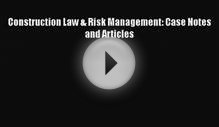
 A effective construction project is dependent about how well project participants manage project risks. Risks are handled through seem business and construction practices and thru careful preparation and overview of the work contract documents. A significant factor of effective risk management starts with how good the work participants allocate risks in the contract formation stage. Ideally, the work documents will allocate responsibility for several risks towards the party best situated to deal with them, therefore reducing the chance and the price of each risk. Following are six key risk allocation and management concepts that needs to be considered in the project contract formation stage.
A effective construction project is dependent about how well project participants manage project risks. Risks are handled through seem business and construction practices and thru careful preparation and overview of the work contract documents. A significant factor of effective risk management starts with how good the work participants allocate risks in the contract formation stage. Ideally, the work documents will allocate responsibility for several risks towards the party best situated to deal with them, therefore reducing the chance and the price of each risk. Following are six key risk allocation and management concepts that needs to be considered in the project contract formation stage.
1. Allocate risk towards the party best situated to manage the danger. In the start of every project, the owner along with a contractor should anticipate and evaluate potential risks to project success and, where relevant, assign responsibility for individuals risks towards the party or parties best situated to manage them. For instance, a specialist should assign the dog owner responsibility for design errors since the owner typically supports the design services contracts and it is inside a stronger position to utilize the work designer to prevent individuals errors. In the owner’s perspective, the contractor should undertake primary responsibility for bodily injuries or damage to property developing from the contractor’s procedures, because the contractor is incorporated in the stronger position to reduce individuals risks keeping a secure jobsite.
2. Allocate risk through indemnity provisions. Contract indemnity provisions generally require one party to cover deficits suffered by another party consequently of claims produced by organizations. A building contract indemnity provision typically necessitates the contractor to indemnify the dog owner against claims for bodily injuries or damage to property developing from the negligent performance of labor through the contractor or its sub-contractors. On the other hand, the dog owner typically is known as onto indemnify the contractor against claims or deficits developing from the presence of hazardous substances in the project site, a minimum of towards the extent the contractor doesn't have any control of individuals substances.
3. Use insurance to aid indemnity provisions. Contract provisions needing insurance policy provide assurance that every party satisfies its indemnity obligations. Drafting effective insurance policy needs in contracts first requires correctly determining the danger obligations assumed by each project participant, after which making certain all parties has got the right insurance to pay for individuals obligations.
For instance, proprietors must require their companies to secure commercial general liability, automobile liability and worker’s compensation/companies liability insurance coverages. These obligations should flow lower to sub-contractors. Commercial general insurance generally covers bodily injuries and damage to property caused by contractor or subcontractor negligence. However, proprietors and companies should keep in mind that liability guidelines typically will not pay for the contractor for defective work, that is rather susceptible to the contractor’s warranty. Similarly, liability guidelines typically will not pay for project enhancements or construction materials for damage because of unknown site conditions, disasters and other alike risks. Individuals damages are handled by a “builder’s risk” policy, that is usually needed to become acquired through the owner.
Contracts with design professionals, for example designers, engineers, and companies carrying out design-build functions, should also require professional insurance to pay for errors and omissions in supplying design or any other expertise. Because professional liability guidelines typically cover claims made on all a specific design professional’s projects throughout confirmed policy period, the aggregate limit of coverage should be sufficiently high to safeguard the dog owner regarding the owner’s specific project. The owner can make this happen by needing project-specific coverage or excess limits relevant to professional liability. For bigger projects, the dog owner might also consider acquiring owner’s protective professional liability to indemnify the dog owner directly for deficits developing in the design professional’s negligence.
4. Require additional insured status and proof of insurance. Proprietors and companies must always require lower tier companies or sub-contractors to include the dog owner and contractor to supplement insureds. A main reason behind additional insured status may be the insurer’s primary duty to protect claims made from the additional insureds. Additional insured status is acquired by endorsement thus, the relevant endorsement ought to be broad enough to pay for ongoing and completed procedures on the primary and non-contributory basis.
RELATED VIDEO











